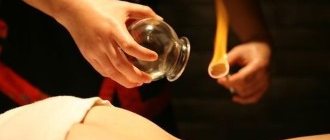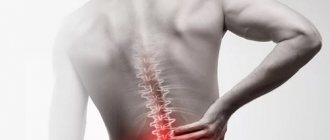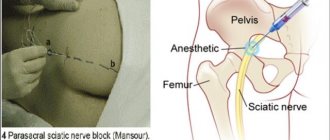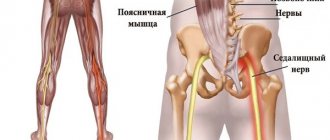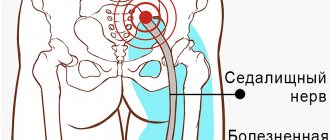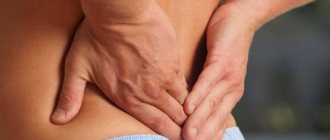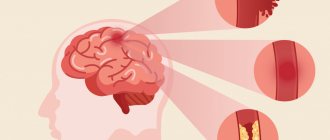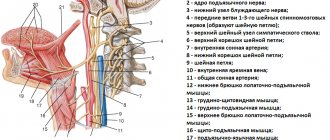The sciatic nerve (sacral plexus) is the largest and thickest nerve in the human body. It is localized in the lumbar spine and passes through the tailbone and lower limbs, reaching the very feet. In an adult, its diameter is 8-12 mm. It is formed by all the roots of the sacral nerve plexus, which is formed by two lumbar and three sacral segments of the spinal cord. This explains the fact that damage to the lower parts of the spinal column often causes pain along the sciatic nerve.
The main functions of the sciatic nerve are to provide sensitive (afferent) and motor (efferent) innervation of the lower extremities. Pinching of the sciatic nerve (sciatica) occurs due to compression of its trunk or root, which is accompanied by severe pain. This is a common occurrence. According to statistics, it can occur in 30% of people who suffer from disorders of the musculoskeletal system.
Causes of pathology during pregnancy and childbirth
The likelihood of a pinched sciatic nerve is not related to the age of the expectant mother. Pathology is diagnosed even in young healthy girls who have not previously had problems with the musculoskeletal system and the spine in particular.
The reasons for the occurrence of a condition where the sciatic nerve hurts during pregnancy and during childbirth may be:
- increased load on the sacral region and the spine as a whole;
- a shift in the center of gravity due to an enlarged abdomen;
- pressure of the enlarged uterus on the sciatic nerve;
- hypothermia;
- excessive physical activity;
- inflammatory processes in the joints;
- multiple pregnancy or large fetus;
- polyhydramnios;
- concomitant diseases - diabetes mellitus, genitourinary system infections, osteochondrosis, thrombosis, spinal injuries;
- intervertebral hernia;
- violation of metabolic processes;
- malignant neoplasms;
- muscle spasms when pushing;
- divergence of the pelvic bones and their return to their natural position;
- postpartum trauma;
- displacement of the vertebrae during childbirth;
- complications during childbirth that required the use of a vacuum or obstetric forceps.
Most often, after childbirth, due to a decrease in load, discomfort disappears without the need for additional treatment. It is important for a young mother to learn how to lift the baby correctly and take a comfortable position while feeding the baby. In rare cases, a woman may need the help of a specialist even after the baby is born.
What is a pinched sciatic nerve?
The sciatic nerve is the largest in our body. It originates from the lower lumbar vertebrae, passes under the piriformis muscle along the pelvis and exits to the legs. Consists of the last two lumbar roots and the first three sacral roots. It is he who forms the sensory and motor branches to the legs, providing the functions of walking. Therefore, any problems with this nerve hinder movement and disrupt the usual rhythm of life.
Pinching is the result of compression of a nerve, which leads to a deterioration in its nutrition and function. Pinching can occur in any area, but the pain syndrome spreads to the entire surface. If the sciatic nerve is inflamed, this indicates prolonged compression and lack of proper treatment. In this case, severe constant pain occurs and gradual destruction of nerve tissue occurs.
Danger of pathology
First of all, sciatica is dangerous due to the threat of miscarriage in the early stages and premature birth in the later stages. Often, symptoms of pinched sciatic nerve that develop before the 10th week do not allow saving the fetus.
The weakening and loss of elasticity of the pelvic floor muscles and adjacent muscle tissue, which is caused by sciatica, can negatively affect the general condition of a woman, both during pregnancy and after childbirth.
Pathology can significantly complicate the process of delivery itself. Hyperthermia and necrosis of surrounding tissue can harm the baby.
Chondroprotectors
Dystrophic changes in joints due to arthrosis and arthritis lead to the destruction of cartilage. The synovial fluid loses its lubricating properties, and instead of sliding between the bones, friction occurs. The cartilage tissue is subjected to additional trauma, which causes pain to intensify.
Chondroprotectors can correct the situation. They speed up metabolism and activate the synthesis of their own collagen, which makes up cartilage. A noticeable effect from their use does not occur immediately, but after several weeks and even months. But it lasts a long time. After a course of procedures, walking becomes easier, movements cause much less discomfort. Chondroprotectors can relieve unpleasant symptoms only in the first three stages of arthrosis, when the cartilage has not yet been completely destroyed. For stage 4 deforming arthrosis, such drugs are useless.
Clinical manifestations
Precursors of the disease - aching, nagging pain in the lower back - may appear even before conception. Often women do not pay attention to this. However, the developing fetus contributes to the worsening of the disease, so you need to take care of your health even at the stage of planning conception.
Symptoms of a pinched sciatic nerve in pregnant women:
- pain in the sacrolumbar spine, radiating to the buttocks and leg;
- pain that gets worse with movement, sneezing or coughing;
- change in gait;
- difficulty changing body position;
- difficulties with extension and abduction of limbs to the sides;
- feeling of numbness and tingling in the limbs;
- insomnia;
- increased fatigue;
- temperature increase;
- disruption of the functioning of some internal organs.
Uncontrolled urination or defecation, sharp unbearable pain in the tailbone area are a sign of a serious illness and require immediate hospitalization.
conclusions
A pinched nerve is a common and familiar problem to many. An awkward movement, heavy lifting, or a sharp turn can cause severe pain and lumbago. Usually, a few days of rest are enough for the pain to subside and completely stop bothering the person. However, if pinching occurs in the pelvic area, in the sacral region, it is better to immediately consult a specialist.
Sciatica is not a separate disease, but a symptom that is often a consequence of degenerative processes in the spine or joints. Therefore, before relieving inflammation of the sciatic nerve, it is necessary to conduct a full examination. A competent and comprehensive approach will help not only relieve pain, but also completely cure the problem. Be healthy!
Diagnostics
Most known diagnostic methods are prohibited during pregnancy. This is due to the high likelihood of harm to the unborn child. To determine the presence of pathology, the doctor needs to interview and examine the woman to determine the nature of the pain, location and frequency of its occurrence.
If it is necessary to clarify the diagnosis, the expectant mother may be sent for an ultrasound. A more informative and reliable diagnostic method - magnetic resonance imaging - is allowed to be used starting from the second trimester of pregnancy.
Hyaluronic acid
Injections with hyaluronic acid replenish the deficiency of synovial fluid characteristic of joint pathologies. It is called “synovial prosthesis”, since the consistency and composition of hyaluronic acid is identical to natural synovium. If there is a lack of it, the articulating surfaces of the bones begin to rub against each other when walking and injure the cartilaginous layer. Hyaluronic acid returns synovium to its normal qualities, at the same time relieving inflammation and stimulating the regeneration of damaged areas.
Therapy methods
During pregnancy, the main thing is not to harm the fetus, so only a qualified specialist should treat the disease. It is necessary to carefully select medications and procedures that do not have a negative impact on the development of the unborn baby.
Drug treatment
The woman is prescribed strict bed rest, as well as injections of anti-inflammatory and painkillers based on ibuprofen or paracetamol. Drug treatment is used only for very severe unbearable pain and can last no more than 5-7 days.
In addition to injections, external agents can be used to treat inflammation of the sciatic nerve during pregnancy. They are less dangerous to the child’s health, since most of them do not enter the bloodstream and do not penetrate the placental barrier. These medications include Menovazin and Diclofenac, which have a pronounced analgesic and anti-inflammatory effect.
The doctor may also prescribe vitamin complexes, chondroprotectors and muscle relaxants that promote complete relaxation of muscle tissue.
Self-medication is strongly not recommended. The use of all types of medications must be agreed with the attending physician.
Physiotherapy
Moderate physical activity is the best way to reduce pain and get rid of pinching. You can do physical therapy during attacks of pain and to prevent them. Systematic exercise helps prevent the progression of the disease and significantly improves a woman’s quality of life.
Exercise "Cat's spine" For pregnant women
For sciatica, you can perform the following set of exercises:
- Get on all fours. Arch your back, lower your head down. Then return to the starting position and raise your head. Perform at least 5 approaches.
- Stand against a wall, pressing your lower back tightly against it. Relax and slightly raise your pelvis. In early pregnancy, the exercise can be performed in a lying position.
- Place a chair in front of you with one leg thrown over it. You need to keep your back straight. Slowly lean forward as far as your enlarged belly allows. Continue the movement until you feel a stretch in the back of your thigh. You need to stay in this position for a few seconds, then return to the starting position and relax.
You need to perform gymnastics slowly, without much tension. It is better to stop exercising if any exercise causes pain or noticeable discomfort. The exercise therapy complex must correspond to the duration of pregnancy, so a physiotherapist or physical therapy specialist should select the appropriate exercises.
Yoga
Yoga classes will help prevent the onset of the disease and significantly reduce the number of attacks if pinching has already occurred. Practice helps strengthen the pelvic floor muscles, normalize blood circulation, and restore proper breathing.
It is necessary to start classes under the supervision of a qualified instructor who has experience working with pregnant women.
It is preferable to sign up for special yoga for expectant mothers, because many classical yoga poses are prohibited during pregnancy, for example, training the abdominal muscles, deep stretching or squats.
Swimming
Water procedures can relieve stress from the spine, reduce pressure on muscle groups and ligaments, thereby reducing pain and the frequency of its occurrence. It is preferable to use indoor pools and attend classes for expectant mothers under the supervision of an instructor.
Swimming helps strengthen muscles and increase their elasticity, greatly facilitates the course of pregnancy and helps the expectant mother prepare for the upcoming birth.
Massage
Massage can only be trusted by an experienced specialist.
Light massage movements of the lumbar region help relax the muscles, thereby reducing the frequency of pain attacks. A massage course consisting of 8-10 sessions will help significantly alleviate the condition.
It is better not to perform massage manipulations yourself at home, but to entrust this activity to an experienced specialist who has skills in working with pregnant women.
Manual therapy and osteopathy
Treatment can be carried out in combination with acupuncture and other similar procedures aimed at reducing the intensity of pain. An experienced chiropractor or osteopath will use gentle massage movements to help relieve pinching and improve the patient’s general condition.
Before using this treatment method, you should consult a gynecologist. Some complications during pregnancy do not allow the use of manual therapy.
Warming up
During the next attack, a warm scarf or blanket that needs to be wrapped around the lower back will help relieve the pain. The use of additional warming ointments and gels is permitted only as prescribed by a doctor. Most medications that relieve inflammation are contraindicated during pregnancy.
You can put warm compresses on your lower back and take salt baths. To do this, you need to dissolve a couple of kilograms of salt in warm water. This procedure is allowed only in the first trimester of pregnancy.
Alcohol lotions and rubbing, for example, tinctures of lilac flowers, horseradish, hot pepper or garlic, can help with back pain caused by a pinched nerve. Such remedies help increase blood circulation and relieve spasms.
Prenatal bandage
Doctors recommend that women wear special devices starting from the 20th week of pregnancy. The prenatal bandage reduces the load on the spine, distributing it evenly across all joints. This reduces pressure on the sciatic nerve and prevents pain attacks.
The device must be selected in size, not restrict movement and not squeeze the stomach. It is better to purchase a bandage in specialized stores and clinics.
How to treat sciatic nerve
Treatment methods always depend on the cause. Therefore, to the question of what to do when the sciatic nerve is pinched, there is only one answer - contact a specialist and conduct a thorough diagnosis. In addition to visual inspection and palpation, as a rule, a full examination is prescribed:
- MRI of the lumbar region;
- X-ray of the lower back and pelvic bones;
- general blood analysis;
- Ultrasound of the pelvic organs.
Some of the first goals of treatment are to relax muscles, relieve inflammation, and improve blood flow to nerve endings. Depending on the diagnosis, the doctor prescribes drug therapy. For this purpose, non-steroidal anti-inflammatory drugs, B complex vitamins and pain-relieving injections are used.
Also, after a complete examination, the specialist will be able to advise how to numb the sciatic nerve at home. Sometimes fixing belts and corsets are prescribed. Therapeutic exercises for inflammation of the sciatic nerve include special exercises that can also be performed at home.
However, competent treatment of a pinched nerve always involves an integrated approach. IVR clinics use a number of effective methods: physiotherapy, exercise therapy, massage, manual therapy. The full treatment program is prescribed individually.
A mandatory stage is rehabilitation, which helps to quickly restore metabolic processes in the spine, normalize blood circulation and tissue nutrition, and strengthen the back muscle corset.
Possible complications and consequences
Women most often encounter pinched sciatic nerves in the second half of pregnancy. The consequences of this condition can be:
- numbness of the limbs;
- neuralgia;
- rachiocampsis.
Only timely, competent therapy will avoid the development of dangerous complications and successfully get rid of the disease.
Sciatica and modern surgery
Despite the wide range of sciatica treatment methods, unfortunately, it is not always possible to achieve the desired results with their help. His victim may be on painkillers for a long time. Without the latter, the disease turns her existence into torture. In such a situation, the doctor will most likely recommend a rather scary thing: surgical treatment of inflammation.
It is indicated when medications and physiotherapy methods of treatment have failed, and the appearance of sciatica is provoked by the following factors:
- intervertebral hernia;
- narrowing of the spinal canal;
- shifts and degenerative changes of the vertebrae.
In addition, the doctor decides on surgical measures in situations of progressive complications (impaired functionality of the lower half of the skeleton, bladder or bowel incontinence).
Surgical treatment for a pinched sciatic nerve is carried out in many ways, but in each case it entails a recovery stage and the need to be present in the hospital.
In particular, during a laminectomy, a certain amount of bone-vertebral tissue and intervertebral particles are removed.
Laminectomy is indicated for entrapment caused by lumbar stenosis. This is a very serious operation, lasting (during normal procedures) from one to three hours, and the period of hospitalization after it is from three to five days.
Discectomy is a classic surgical practice that involves removing elements of the spine (complete or partial). The above procedure is suitable for getting rid of a hernia, including stenosis. In this case, it is possible to restore disc structures using grafts. The duration of the above operation is at least two hours.
The techniques described are very traumatic: a large incision is made, cutting muscles and ligaments. Large-scale removal of spinal elements leads to an increase in the load on the operated part of the skeleton. On top of that, the percentage of failure of the discussed venture remains quite high
Low-traumatic methods for treating sciatica include microdiscectomy and laser discectomy.
Microdiscectomy is performed quite quickly - within half an hour. In this case, practically no traces are left on the patient’s body, since the incision on the skin during microsurgery is only a couple of centimeters. The hernia is removed with minimal destructive effect on bone tissue. Hospitalization after the mentioned micro-operation lasts for two to four days.
Laser surgery can be considered the most progressive treatment option for pinching.
The surgeon also performs all manipulations through a small incision. The tissue to be removed is excised with a laser device. The above-mentioned minimally invasive interventions reduce the risk of complications and minimize damage to internal and external bodily structures.
However, even the most modern surgical technologies do not provide a 100% guarantee of success and entail a long recovery period.
Rehabilitation after the intervention sometimes drags on for months.
It involves a course of massage, special exercises, swimming, physiotherapeutic and drug treatment.
At the same time, a number of restrictions are introduced into the patient’s daily life. He will need to wear a post-operative support bandage and limit bending, heavy lifting, prolonged sitting, and driving. Strict adherence to these rules is necessary for successful recovery.
Considering the above, it is quite difficult to decide on the types of treatment listed above. Fears and concerns typical of a sane representative of humanity push many to search for non-surgical options for treating inflammation of the sciatic nerve.
Fortunately, they exist. The specialists of the Osteopathy Center, who work for the benefit of health, know this for certain.
Preventive measures
To significantly reduce the risk of pathology, you must adhere to the following recommendations from doctors:
- in late pregnancy, wear a bandage;
- to refuse from bad habits;
- walk in the fresh air more often;
- wear comfortable clothes and flat shoes;
- perform special gymnastics, swim and do yoga;
- purchase an orthopedic mattress and pillow for pregnant women;
Maternity pillow - watch your posture;
- eat properly and nutritiously;
- control your weight;
- do not lift heavy objects;
- reduce the intensity of physical activity;
- avoid hypothermia;
- take complex vitamins and calcium supplements.
Don’t be shy about asking your loved ones for help and delegating some of your responsibilities to them. A pregnant woman needs to rest more often during the day, fully relax all muscle groups, and relieve stress from the spine and lower extremities.
Advantages:
Anesthetic injections for pain in the hip joint are a way to relieve severe pain in the shortest possible time. The effect of chondroprotectors and other therapeutic agents lasts for a long time. A course of intra-articular injections allows you to delay and even avoid surgery, reduce the dosage and amount of medications taken, which is very important for problems with the digestive organs. Injection therapy can be repeated many times, since adverse reactions and complications are rare. The procedures have a beneficial effect on cartilage, accelerating healing and slowing down destructive processes.
Osteopathic treatment for sciatica
Osteotherapy is an amazing medical field that allows you to overcome sciatica without resorting to surgery or medications. It perceives a person as a whole, reveals the subtlest deep relationships within him and, getting to the true essence of the problem, eliminates it, thereby relieving pain and any other uncomfortable symptoms of the disease.
An osteopathic doctor can relax cramped muscles, reduce inflammation, and return displaced vertebrae and joints to their place. The treatment in question triggers the self-healing functions that lie dormant within each of us and has a positive effect on the general well-being of the patient. His pain goes away, his posture and complexion improve, and his sleep normalizes.
For some, it is extremely important that the treatment does not cause discomfort; others are afraid to use medications or have difficulty tolerating them.
You can forget about these fears by contacting an osteopathic doctor.
Osteopractic sessions are easy and most often painless. Some say they resemble a massage, while others compare them to magic. This is true medicine that works real miracles. The sensitive and caring attitude of our Center’s specialists towards patients under their care, as well as their high professionalism and invaluable work experience, contribute to the fact that treatment is gaining rapid positive dynamics.
The patient recovers quickly, he does not have to take a huge amount of expensive medications or go under the knife to a surgeon.
However, osteotherapy does not exclude pharmacological therapy if there is a desire or need.
In particular, specialized ointments will help reduce inflammation and pain, easing the course of the disease on the path to healing. An entire section of alternative medicine, called homeopathy, is engaged in the development of remedies suitable for use for medicinal purposes for the above-mentioned disease.
The homeopathic doctor at the Osteopathy Center individually selects the necessary medications, making the treatment of our clients complex and comprehensive.
Osteomedicine has virtually no contraindications. It can be used to eliminate sciatica at any age, as well as during pregnancy. In the latter situation, among other things, osteopractice will help normalize blood flow, which will have a positive effect on the condition of the unborn baby, as well as on his life activity in the future.
Depending on the essence of the problem and the individual characteristics of the patient, the doctor uses certain techniques to overcome the disease.
Along with classical osteopractice techniques, manual osteotherapy gives good results.
She specializes in deep study of the insides, the fight for the healing of the spinal column.
Manual osteomedicine helps to heal pain associated with hernia formations, stopping their development and even promoting their regression.
The chiropractor works with muscle fibers, tensing and relaxing them, and also carries out rhythmic movements of the joints of his client, performing various twists and stretches.
The client usually does not experience any pain at all.
Acupuncture, or, as they say now, reflexology, is a reliable assistant that helps overcome illness, eliminating pain and improving well-being.
Activation of special points on the human body allows you to increase blood supply and metabolism, restore neural conduction in the area affected by inflammation.
Acupuncture is an excellent alternative to anesthetics; it can be used to relieve pain without using these medications.
